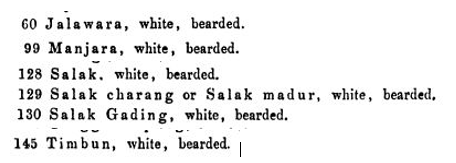
Sundanese language, manuscripts & scripts enthusiast | Admin https://t.co/v0muxHf0Ic | Wikipedia | EN/ID/SU | he/him
How to get URL link on X (Twitter) App



 Terlihat penggunaan huruf <c> ( ڄ) pada kata "maca" (مَڄَا), yaitu huruf ha dengan titik dua vertikal di bawah; <ng> (ڠ ) dalam "ngadangding" (ڠَادَڠْدِڠْ) yaitu huruf 'ain dengan titik tiga di atas, dan <g> (ࢴ) dalam "margi" (مَرْࢴِي) yaitu huruf ka dengan satu titik di bawah.
Terlihat penggunaan huruf <c> ( ڄ) pada kata "maca" (مَڄَا), yaitu huruf ha dengan titik dua vertikal di bawah; <ng> (ڠ ) dalam "ngadangding" (ڠَادَڠْدِڠْ) yaitu huruf 'ain dengan titik tiga di atas, dan <g> (ࢴ) dalam "margi" (مَرْࢴِي) yaitu huruf ka dengan satu titik di bawah.

 I curious about this fragment due it uses old Sundanese language. I'm quite sure that it is a prose rather than a poem. The beginning should be the left fragment, because it has a distinctive symbol.
I curious about this fragment due it uses old Sundanese language. I'm quite sure that it is a prose rather than a poem. The beginning should be the left fragment, because it has a distinctive symbol. 

 This manuscript is in the possession of the National Library of Indonesia number 15 L 615. The text written in old Sundanese language and old Sundanese script on 5 folios of palm leave.
This manuscript is in the possession of the National Library of Indonesia number 15 L 615. The text written in old Sundanese language and old Sundanese script on 5 folios of palm leave.

https://twitter.com/inurwansah/status/1268378786497585153
 But, I'm not sure if these copper inscriptions are the 'paripih.' mentioned in SSMG. I found interesting word comparison in Balinese language > peripih, (meripih) wear an amulet, wear a magic belt <
But, I'm not sure if these copper inscriptions are the 'paripih.' mentioned in SSMG. I found interesting word comparison in Balinese language > peripih, (meripih) wear an amulet, wear a magic belt <

https://twitter.com/inurwansah/status/1266606191624347650Its poles made of engraved iron, the roof of China iron, the floor of 'maléla' (alloy?) iron, the wall of yellow iron (brass?), and the roof top of 'panamar' (prestige?) iron.

https://twitter.com/inurwansah/status/1260119095459995648
 I found at least four variety names of the rice matched in the Dictionary of Sunda Language of Java. Even the descriptions are not detail, but at least I can get information about the color and 'beard'.
I found at least four variety names of the rice matched in the Dictionary of Sunda Language of Java. Even the descriptions are not detail, but at least I can get information about the color and 'beard'. 

https://twitter.com/inurwansah/status/1260099292011749376This part is very well-known in the Sundanese oral literature. There is a Sundanese oral story called 'carita pantun', that also tells about this story, but off course with some differences. The title is Carita Pantun Sri Sadana, or Sulanjana.

 The text written on lontar palm leaves with old Sundanese script and language. There's no explicit date written, but from the usage of the script and language, I can say it produced some times at the pre-Islamic period in West Java. Probably from 15-16 century AD.
The text written on lontar palm leaves with old Sundanese script and language. There's no explicit date written, but from the usage of the script and language, I can say it produced some times at the pre-Islamic period in West Java. Probably from 15-16 century AD.



 Setelah beberapa lama "ngahuleng" melihat susunan ini, saya transliterasikan seperti ini:
Setelah beberapa lama "ngahuleng" melihat susunan ini, saya transliterasikan seperti ini: 
 Gambar ini adalah potongan teks Śikṣā Guru yang menyebutkan ḍuka saṅka ri dewata —salah satu bagian dari pañcakapataka dalam Saṅhyaṅ Sasana Maha Guru—yaitu beberapa kesengsaraan (sensasi sakit) pada tubuh manusia yang berasal dari dewata.
Gambar ini adalah potongan teks Śikṣā Guru yang menyebutkan ḍuka saṅka ri dewata —salah satu bagian dari pañcakapataka dalam Saṅhyaṅ Sasana Maha Guru—yaitu beberapa kesengsaraan (sensasi sakit) pada tubuh manusia yang berasal dari dewata.

 Musik tradisional Sunda yang diketahui saat ini sangat banyak ragamnya. Beberapa di antaranya terbuat dari bahan bambu, seperti angklung, suling, calung, dan arumba. Instrumen angklung tentunya sangat akrab di telinga orang Indonesia, bahkan hingga mancanegara.
Musik tradisional Sunda yang diketahui saat ini sangat banyak ragamnya. Beberapa di antaranya terbuat dari bahan bambu, seperti angklung, suling, calung, dan arumba. Instrumen angklung tentunya sangat akrab di telinga orang Indonesia, bahkan hingga mancanegara.

 Pengetahuan tentang berbagai jenis logam dan pengolahannya pada masa Sunda kuna telah berkembang cukup baik. Bukti tekstualnya tertera dalam naskah-naskah Sunda kuno dari sekita abad ke 14 hingga abad ke-16 Masehi.
Pengetahuan tentang berbagai jenis logam dan pengolahannya pada masa Sunda kuna telah berkembang cukup baik. Bukti tekstualnya tertera dalam naskah-naskah Sunda kuno dari sekita abad ke 14 hingga abad ke-16 Masehi.